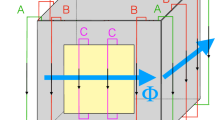Abstract
In NO-experiments at very low temperatures problems arise from the finite life-time of the nuclei and the radioactive self-heating of the source. Recent developments of top loading hyperfine enhanced nuclear demagnetization cryostats of small cooling power give fast access to temperatures around 1 mK. To reach lower temperatures the bottleneck of thermal contact must be overcome in order to cool samples which are themselves the main source of heat. In this context the limitations of nuclear demagnetization cryostats are discussed with respect to their application in “brute force”- and NQR/NMR-experiments.
Similar content being viewed by others
References
Oxford Instruments LTD, Osney Mead, Oxford OX2 ODX, England
S.H.E. corporation, 4174 Sorrento Valley Blvd.,San Diego,U.S.A.
An introductional description of this cooling technique as well as the technique of dilution refrigeration can be found in: O.V. Lounasmaa, Experimental principles and methods below 1K. Academic Press Inc. (London) 1974 and
O.V. Lounasmaa. J. Phys. E 12 (1979) 668 and
D.S. Betts, Refrigeration and thermometry below 1K. Sussex University Press (1976)
G. Frossati, thesis, Université de Grenoble (1978)
G. Frossati, H. Godfrin, B. Hebral, G. Schumacher and D. Thoulouze, Proc. ULT Hakone Symp., eds. T. Sugawara, S.Nakajima, T. Ohtsuka and T. Usui (Phys. Soc. of Japan,Tokyo, (1978))
G. Frossati, J. de Physique C6 (1978) 1578
G. Frossati, private communication; the new dilution unit at Leiden is running at 1.9 mK
Chr. Probst, unpublished; the unit is comparable to Oxford-400 but reaching 3.5 mK; the same 4-Ag-exchanger-set is used
K. Uhlig, thesis, TU-Munich (1982); uses Cu-step exchangers
K. Neumaier, unpublished; small unit with one Cu-step exchanger
K. Neumaier, A. Heidemann and A. Magerl, ILL-Grenoble, internal report (1983); “dip-stick” unit; the unit can be inserted as a whole into the dewar
P. Herzog, private communication and this volume
K. Andres and S. Darak, Physica 86–88B (1977) 1071
K. Andres, E. Hagn, E. Smolic and G. Eska, J. Appl. Phys.46 (1975) 2752
G. Eska, K.Neumaier, W. Schoepe, K. Uhlig and W. Wiedemann, Phys. Rev. B27 (1983) 5534
E. Schuberth and G. Eska, unpublished
D.I. Bradley, A.L. Allsop and N.J. Stone, Proc. LT17 (Karlsruhe), eds. Eckern,Schmid, Weber and Wühl, North Holland, (1984) 1159
G. Eska, thesis, TU-Munich (1971)
D.I. Bradley, A.M. Guenault, V. Keith, C.J.Kennedy, I.E.Miller, S.G. Mussett, G.R. Pickett and W.P. Pratt,Jr., J. Low Temp. Phys.57 (1984) 359
R.M. Mueller, Chr. Buchal, H.R. Folle, M. Kubota and F. Pobell, Cryogenics20 (1980) 395
H. Ishimoto, N. Nishida, T. Furubayashi, M.Shinohara, Y.Takano, Y.I. Miura and K. Ono, J. Low Temp. Phys.55 (1984) 17
G. Eska and E. Schuberth, to be published
P. Walker, this volume
J. Hook, private communication
F. Pobell, private communication
DM 35 000.- is3the estimate for the whole system, including Dewar, pumps, He handling and dilution unit
E. Schuberth, Rev. Sci. Instrum.55 (1984) 1486
Cryogenic Consultants LTD, Metrostore Bldg., 231 the Vale, London W3 7QS, England
G. Eska and K. Neumaier, Cryogenics23 (1983) 84
M. Kubota, H.R. Folle, Ch. Buchal, R.M. Mueller and F. Pobell, Phys. Rev Lett.45 (1980) 1812
M. Reiffers, K. Flachbart, S. Janos, A.B. Beznosov and G. Eska, Phys. Status Solidi B109 (1982) 369
R.M. Mueller, this volume
U. Angerer and G. Eska, Cryogenics24 (1984) 515
D.D. Osheroff, private communication
Y.S. Karimov and I.F. Shchegolev, JETP14, (1962) 772
A. Benoit, J. Flouquet, D. Rufin and J. Schweizer, J. de Phys. Lett.43 (1982) L431
P.R. Roach, B.K. Sarma, M.L. Vrtis, S.K. Sinah, K. Skold, J.B. Ketterson and W. Halperin, Argonne Nat. Lab. IPNS6, 1 (1983)
Y.H. Tang, E.D. Adams, K. Uhlig and D.N. Bitter, Proc. LT17 (Karlsruhe),eds. Eckern,Schmid, Weber and Wühl, North Holland, (1984) 1161
Author information
Authors and Affiliations
Rights and permissions
About this article
Cite this article
Eska, G. Very low temperatures and their applications in nuclear orientation. Hyperfine Interact 22, 221–234 (1985). https://doi.org/10.1007/BF02063996
Issue Date:
DOI: https://doi.org/10.1007/BF02063996




